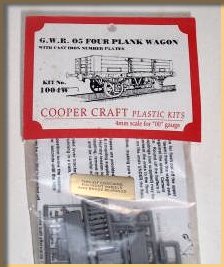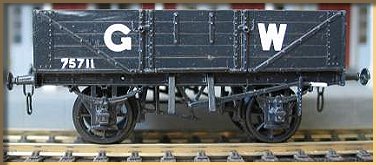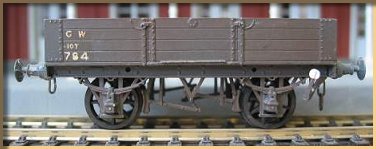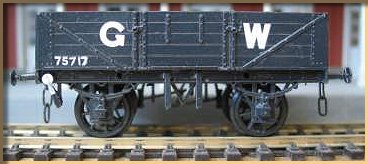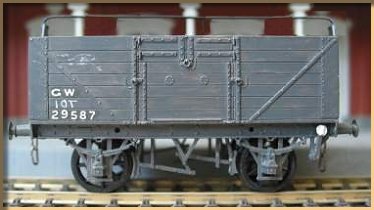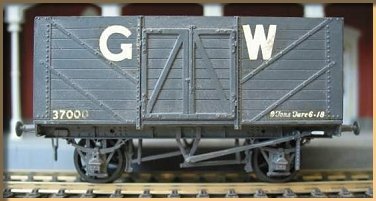| Section Page | Previous Page | Next Page |
Cooper-Craft 4mm open wagons – an introductionby Graeme PettitIntroduction
This range of kits are excellent for the beginner. They have been well thought out, and have simple instructions and support diagrams. I particularly like the softer plastic from which these kits are moulded. A selection of my Cooper-Craft Opens are illustrated below, along with a few notes. As you may gather from some of the photos, the buffers are prone to breakage. I recommend fitting cast types from ABS or similar. Alternatively I believe some of the MJT buffer offerings may be suitable, but have not tried many of the range, so am unable to comment further. If you find some on another kit, try approaching the supplier of the kit, and asking if parts are available separately – most suppliers are willing to oblige at a price, and some are better than others. Watch too, how you build the brakes on these wagons. Work from photographs if possible. The kits below were built before I had expanded my library to cover GWR items to the extent I have now, and so the configuration of brakegear is not entirely correct on all the wagons.
This represents wagons built from 1903, and fitted with a Williams patent sheet supporter rail (folded down and out of view on this model). The sheet supporter rail was later removed when wagons of the type were not returned to the GWR after the RCH wagon pool was developed during WWI – see kit 1005 below. These wagons were fitted with DCI brake, which is not supplied in the Cooper-Craft kit, many were later fitted with a lever brake on the other side.
This kit, as supplied, does not properly represent diagram O5 as it says it does, but the bigger picture is more complicated. The GWR had approximately 18000 4-plank open wagons, built with single-sided lever brakes. They were not initially given a diagram (the diagram index beginning only in 1905). In addition, 200 wagons were built with the same body as featured in the kit but with DCI brakes and sheet supporters (not supplied in the kit) – they were classed as diagram O5. The undiagrammed wagons would later receive a third brake shoe with its own independent lever and be amalgamated under the umbrella diagram 'O21'. Some of these wagons received sheet supporters. The DCI-fitted O5 wagons would later also be fitted with a third brake shoe. After the O5 diagram, no more 4-plankers were built, the higher 5-plank diagram O4 finding favour instead for general purpose use. This wagon has been fitted with the only spare set of buffers I had left at the time – they are LBSCR pattern, and will be replaced by cast items at some future date when I rebuild the kit with the brake gear the correct way around, and fit the door springs which are missing. Can't the camera be cruel!
This kit is the same wagon as kit 1001 but in its later, 1925 guise after inclusion in the Railway Clearing House wagon pool. It was found that many of the sheet rail fitted wagons did not return to the GWR as other companies found them so useful, so the GWR removed all sheet rails from Common User or 'pool' wagons to ensure their return more frequently. The kit comes supplied with the option to build either the Churchward brake system, or the later, lever type of brake. My example here is fitted with single-sided DCI Brakes, and needs cross rodding to finalize. Some further 4-plank open suggestions can be found on on RMweb
Between 1905 and 1907, approximately 1500 of this design of wagon were constructed. The intent was to use them for general merchandise rather than mineral use, and the extra height afforded by the two extra planks over the 5-plank allowed larger volumes of lightweight goods to be carried, which could be kept dry via use of the provided sheet rail. Many survived well into the 1950s and beyond. The O2 was built with DCI brakes, and therefore cannot be portrayed by the Cooper-Craft kit, but the vacuum-fitted O10 had DCII brakes, for which the kit is suitable.
With a strong emphasis in the early years on the use of horse drawn-transport, the GWR developed a central depot at Didcot for the distribution of animal feed throughout its network. 'Provender' actually refers to the term then used to describe hay and bedding straw – a lightweight, yet very bulky material, which proved awkward to move in quantity using the existing wagon fleet. The GWR, therefore, developed these highly specialised wagons strictly for the purpose of conveying this traffic where needed. Two batches were built – one in 1888, and a further batch in 1903. The kit represents the later batch, with an 11' wheelbase, 18' long, 8'6" wide. They could be found anywhere where horses were used, and often ran supported by diagram O2 wagons (kit 1006), which carried heavier feedstuffs to the same locations. Loads on both would frequently be covered with tarpaulins if inclement weather was expected between loading and unloading. No. 37000 above represents the kit built as supplied with no modifications. It is an easy kit to construct, and recommended as a beginners project. It makes into an unusual, but fairly common prototype. You can see more examples of the Cooper-Craft open wagons in the showcase section.
Please note: The author has no affiliation with Cooper-Craft. |
| Section Page | Previous Page | Next Page |
